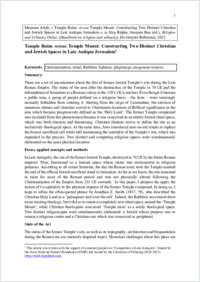A Pagan Temple, a Martyr Shrine, and a Synagogue in Daphne : Sharing Religious Sites in Fourth Century Antioch
BHAP-HA+SCANT
- Attali, Maureen ORCID University of Fribourg
- Massa, Francesco ORCID University of Fribourg
- 2021
Published in:
- Geographies of Encounter: The Rise and Fall of Multi-Religious Spaces / Burchardt, Marian ; Giorda, Maria Chiara. - Malden, MA: Palgrave. - 2021, p. 1-28
saint Babylas
martyr shrine
temple of Apollo
Emperor Julian
John Chrysostom
Maccabean martyrs
Matrona
synagogue
English
During the late fourth century CE, Daphne near Antioch in Roman Syria was a place of both cohabitation and confrontation between various religious groups and contributed to the construction of their religious identity. In 351-352, the corpse of a Christian martyr named Babylas was buried near the famous temple of Apollo. Some 10 years later, the emperor Julian had the body sent away on the ground that it impeded the pagan cult, hoping that its disappearance would cause Apollo to return. However, the famous Christian preacher John Chrysostom argued that the power of the martyr lingered in Daphne even after his coffin was removed, thus asserting the supremacy of Christianity over the pagan god. While trying to verbally christianize Daphne’s space, Chrysostom also disparaged the local synagogue, even though it was a popular spot for local Christians and may have been dedicated to Biblical figures who were also worshipped by them. He did so to enforce the spatial and theological boundaries between Jews and Christians.
- Faculty
- Faculté des lettres et des sciences humaines
- Department
- Département d'histoire
- Language
-
- English
- Classification
- Ancient history
- License
-
License undefined
- Open access status
- green
- Persistent URL
- https://folia.unifr.ch/unifr/documents/312381
Statistics
Document views: 556
File downloads:
- attali_2022_temple: 344
